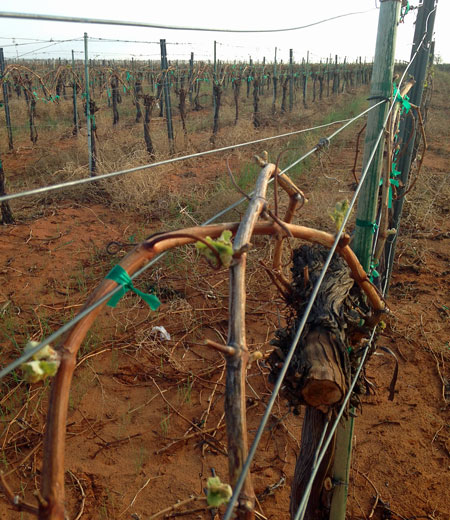
Texas High Plains Report: It’s Alive! It’s Alive!
I just received a photo from a certain (and notable) viticulturist on the high plains. Like many that reside near him, he didn’t hold out much hope for the naked and infantile buds on the vines in his area after last week’s freeze. This sad prognosis was particularly true for the early budding and Texas popular white grape varieties like Viognier. Click here for more.
But, as you can see in the picture above, the tender gray-green of life still exists at multiple points on a cane of Texas high plains Viognier.
As you may have seen commented during the past week on Facebook or the Yahoo Groups Texas Winegrowers, many high plains grape growers used a variety and often multiple approaches to mitigate the spring freeze. Some used newly installed wind turbines while others burned hay, cotton and what other surplus materials they had at hand. Some made fires while also moving air around over their vineyards with helicopters flying aloft.
Another perhaps more subtle but apparently still effective approach is the one shown in the photo. It’s called Cane pruning. This is hardly a new and innovative approach to vineyard management, but one commonly used in cooler climate and higher latitude winegrowing like in Burgundy. It might seem a bit contra-intuitive. After all Texas IS a warm growing, low latitude wine growing region, right? In such areas, a common vine pruning technique is spur pruning. If you go to southern Rhone Valley in France or in many places in California you will usually see spur pruned grapevines. What’s up?
Well, in spur pruning you look at the new, one-year-old wood growing from the spurs (spurs are long canes that are pruned to the size of short twigs) of a cordon (or arms of the vine extending from the trunk). What you usually want are two to four buds on each spur. This is achieved by pruning off everything else. As the new growth progresses from these spurs, it will be trained by attaching it to a trellis wires. In this method, you basically have only a few shots at viable bud growth. But, the good part of it is that it focuses the vine’s energy to producing as much fruit as it can from these few shoots.
Cane pruning involves cutting back nearly all of the last year’s growth. To cane prune a grapevine, normally two well-formed canes growing out of the head of the vine are spared. These canes are tied to the trellis wire. These remaining canes provide many more possibilities for viable growth than usually available from spur pruning. This is why it is often used in colder regions that have late freezes and unfavorable spring weather that can adversely affect the buds. On the downside, it is more manual labor intensive than spur pruning and it can limit the maximum production capacity of the vine than with spur pruning.
I’m far from an expert on grapevine pruning, but from the continuous issues caused in Texas from spring freezes and from the initial results, cane pruning may be another new arrow in the Texas winegrowers quiver to shoot at our springtime weather problems that greatly limit Texas grape and wine production.

